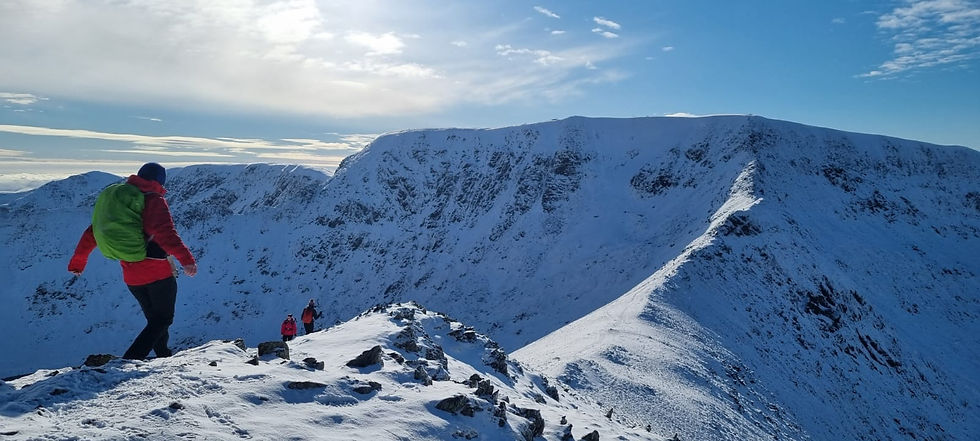Winter courses with Lake District Mountaineering are designed to offer a progressive and structured journey from winter skills to winter mountaineering on graded ground and finally onto winter climbing.
The courses are mainly based in the Scottish Highlands, to make use of more reliable winter conditions as well as taking advantage of the amazing mountain terrain Scotland has to offer.
We are mainly based in the Cairngorms throughout the period, using Aviemore as our base but your course may make use of the west coast (Ben Nevis and Glen Coe) on some days if appropriate to do so.
The Courses
A quick summary of the courses.
Winter Skills
Our Winter Skills are designed to build a solid foundation of winter walking skills and provide a platform for your independence. They are also structured to build the base knowledge needed to progress towards our mountaineering programme.
Winter Mountaineering
Mountaineering includes the skills to get ready to tackle winter ridges, gullies and scrambling terrain with one axe, up to grade II. Making use of steeper snow slopes, more advanced axe and crampon techniques and looking at the use of rope work and snow belays to stay safe.
Winter Climbing
The winter climbing courses make use of two axe climbing on snow, ice and mixed routes. Using techniques such as swinging, hooking and torquing to ascend winter climbs, we will be looking at climbing rope work and safety on steep terrain.

Here’s a comprehensive guide to what you’ll need to bring, along with some expert recommendations.
Clothing: Layering for Winter Success
Winter conditions can change rapidly, so dressing in layers is key to staying warm and comfortable:
Base Layer: A moisture-wicking thermal top and bottom to keep sweat off your skin. Merino wool is lightweight and odourless, so is the ideal choice here. Take a look at these baselayers from Decathlon.
Top tip: bring two baselayers when climbing, and change into a dry one when you gear up, this way you'll not get cold from the sweat that has built up on the walk in.
Mid Layer: Fleece or insulated layer for warmth. I wear a Mountain Equipment Switch jacket but there are lots of fleece materials on the market.
Outer Layers: A waterproof and windproof jacket (preferably Gore-Tex Pro or similar materials). A high denier fabric will be best for use in Scotland against high winds, rain and snow: A Mountain Equipment Tupilak for example.
Salopettes: Salopettes are recommended as they come with a bib, braces and internal gaiters, all essential to keeping the weather out. Top tip: a high waist/bib is important so snow doesn't blow up your back when you bend over to get something from your rucksack (preferably Gore-Tex) - Mountain Equipment Tupilak
Insulated Jacket: A synthetic jacket for extra warmth. It is recommended to get a synthetic jacket rather than a down jacket as it will retain its warmth when wet and not get ruined once saturated. These jackets are great for breaks, such as lunch or an unplanned stop in an emergency. They are also great for standing on belays when climbing. They go on over all of your layers when stationary, and come off again once you're moving. Take a look at the Mountain Equipment Fitzroy
Gloves: Three pairs of insulated gloves with a leather palm and a thinner glove for dexterity. My glove selection is: Alpkit Haline for walking in, Mountain Equipment Hard Mixed for climbing and dexterous jobs and the Mountain Equipment Guide as a warm pair. On really cold days, I will carry a pair of mittens too (all my gloves have a leather palm). Top tip: multiple gloves are best. Once wet, discard into your rucksack and get a dry pair. Dry = warm. In general, I have a walking in pair, a climbing/doing pair and a walking out pair. The mittens would be for an emergency or prolonged stop.
As a rule: don't spend big on one pair of gloves - the £180 gore-tex gloves will wet out eventually - spend the same amount on 3-4 pairs.
Hat and Buff: A warm hat that covers your ears and a buff or balaclava to protect your face from wind and cold. A thin hat to go under a helmet is a good investment.
Socks: Thermal, moisture-wicking socks. Top tip: ski socks or socks that go over your calf muscles will keep your feet warmer, as you keep the big muscles warmer where the blood flow is.
Gaiters: To keep snow out of your boots. Some salopettes come with in built gaiters, as do some boots so make sure snow can't get in over the top; your feet will get cold and wet before we've even started! Top tip: I prefer short gaiters, and generally they are worn underneath your waterproof overtrousers, but if it's your first time in crampons you may want some higher gaiters worn over the top, so you don't put your spikes through your expensive trousers when learning!
Goggles: Get some goggles. This is very important. A clear lense is best, as you will use them mostly in low light but they stop the snow and ice being blown into your face and stinging your eyes. Top tip: wear your goggles over your hood and pin it down, this reduces condensation and means your hood stays on your head when windy.

Swirral Edge - mountaineering in the Lake District
Footwear: Stiff, Stiff, Stiff (B2 & B3)
Winter Boots: Stiff-soled, waterproof boots that are compatible with crampons. If buying your own, make sure they fit.
Recommended models - B2: Scarpa Manta Tech. B3: La Sportiva Nepal Extreme
Winter Walking: B2 boots will be sufficient. They are stiff enough to allow a bit more comfort but will perform well in the snow, ice and neve.
Winter Mountaineering: B2 will work, but a B3 may be better as we will be more reliant on the rigidity of the boots, using the edges for kicking and relying on the front points when ascending steeply, so the less flex the better.
Winter Climbing: B3 boots are ideal, you don't want any flex so you can stand firmly on your crampons, especially on rock edges and ice.
B3 boots can be rented from Tiso or Ellis Brigham, as we only have B2 in our stocks currently.
Essential Technical Equipment
For a winter mountaineering/climbing course, you’ll need specific tools to navigate icy terrain and snow-covered slopes:
Ice Axe: Used for self-arrest, cutting steps, and general stability on steep terrain. Take a look at the Petzl Sum-Tec. The Sum-Tec is a modular axe that is great for mountaineering, but will progress well into climbing up to Grade III when paired. We will hire DMM Spire Tech axes to you on a mountaineering course if you rent directly from LDM.
For Climbing we can hire you Petzl Quarks, or DMM Fly's (the Fly's are a discontinued axe now) but both are suitable for ice and mixed climbing. A set of leashes will also be needed but these can borrowed with the ice axes. Climbing axes come in pairs and are made up of an adze and hammer.
Crampons: Check they fit your boots securely before you set out. We will hire Grivel G10 for winter skills and walking courses. For mountaineering courses, you will need a C2 crampon: we hire Grivel G12 and this is what we recommend. Make sure they are the New-Matic version if buying your own. For climbing courses, the G12 will work and we also rent out Petzl Sarken crampons.
If you buy or use C3 crampons, please consult with us as we can advise whether they will work with your boots. C3 needs B3, there is a welt in the front of the boot for the metal bar to sit.
Helmet: A climbing helmet to protect against falling ice and rocks. This will be worn in steep terrain, or whenever we put crampons on. A climbing specific helmet from Petzl or Black Diamond will be best. We can hire these to you.
Harness: For any technical sections requiring ropes. A Black Diamond Momentum would work fine and is a great option for a budget harness. We can hire a simple harness to you.
Belay Device and Carabiners: Screwgate carabiners, 120cm slings and a belay device for ropework. We can hire these out to you.
Rucksack: A 35-45L rucksack to carry all your gear comfortably. Everything has to go INSIDE the rucksack, no exceptions. Make sure its comfortable and is big enough for all the extra gear that's needed.

Climbing on Aonach Mor
Safety and Navigation Gear
Even with a guide, it’s wise to carry personal safety and navigation tools:
Map and Compass: Our courses will cover some map and compass skills in the winter environment, we hope to build on pre-existing summer skills. We can provide maps and compass, but if you bring your own you will need a 1:50,000 or 1:40,000 map of the area and a Silva Expedition Type 4 compass.
GPS Device or Smartphone App: For backup navigation. Back-up only, its very hard to use a phone with gloves and goggles in 40mph winds.
Head Torch: With spare batteries, as winter days are short.
First Aid Kit: Blister plasters and any personal medication. (inhaler, epipen as examples)
Emergency Shelter: A group shelter or bivvy bag - this can be supplied and each group will carry one on the mountain.
Food and Hydration
Snacks: High-energy foods like trail mix, chocolate, and energy bars.
Lunch: Something easy to eat, like sandwich rolls or wraps. These can be forced down quick and don't take up too much space; also it doesn't matter if they get a bit squished. Top tip: store your sandwiches in your helmet, it creates a vacuum of space in your rucksack.
Flask: A hot drink can be a morale booster. I like hot squash rather than coffee; warm, sweet and easy to drink with some energy in it.
Water Bottle: Ensure water won’t freeze, or use an insulated sleeve. Top tip: Fill the bottle to two thirds, and store it upside down in your rucksack, the water will freeze top down; this way you'll always be able to drink from the top. Ideally you'll have a Nalgene style as they don't leak.

Winter Skills courses for winter walkers
Optional but Useful Extras
Sunglasses and Sunscreen: Snow glare can be intense, even in winter. Especially around March time when the days are nicer.
Camera: To capture the stunning scenery.
Trekking Poles: Very useful for stability on snow-covered paths and in high winds. Poles that break down small, like a Z-pole are extra useful as you can store them away when climbing or using an ice axe - these are more expensive but worth it. Top tip: avoid carbon in the cold.

Snow and ice climbing in The Cairngorms
Recommendations from Lake District Mountaineering
For your course, we can provide lots of specialist equipment such as ice axes, crampons, helmets, and harnesses and even boots. Be sure to check with us in advance so you don’t bring unnecessary items or gear that isn't suitable. All of our course notes will help you plan accordingly once you have booked with us. Additionally, consider:
Pre-Course Training: Familiarise yourself with basic skills such as walking in crampons and using an ice axe if coming on a more advanced course. This might mean coming on a basic skills course first.
Fitness: This is especially important as we will be walking for long periods in snow, carrying heavier bags and wearing stiff boots. Consider some cardio work or some big mountain days to gain hill fitness to get the most from your course.
Weather Knowledge: We will try our best to make use of the best areas for the given weather in your course, but we may undertake activities such as summer mountaineering, indoor bouldering or dry tooling if the weather isn't safe or appropriate for winter climbs.
Practice Packing: Ensure all your gear fits comfortably in your rucksack. Have a system and an order so you know where everything is in your bag. This is what we call personal admin and it needs to be tip top in the winter environment.
Practice with your gear: In your living room, practice fitting your crampons, practice zipping up your jacket, practice fastening your rucksack straps - do all of this with your gloves on. Wear your biggest gloves and do these tasks; doing these in the cold and needing gloves on catches a lot of people out when they come and do it for real.
By coming prepared with the right equipment, you'll be ready to embrace the challenges and beauty of a Lake District winter course. With the guidance of Lake District Mountaineering, you’re set for an unforgettable adventure. Happy mountaineering!

*All opinions are my own - Sam Marsland (WMCI)







Comments